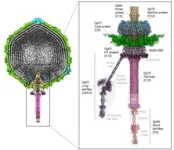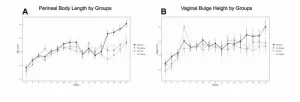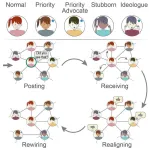(Press-News.org) BIRMINGHAM, Ala. – The viruses that infect bacteria are the most abundant biological entities on the planet. For example, a recent simple study of 92 showerheads and 36 toothbrushes from American bathrooms found more than 600 types of bacterial viruses, commonly called bacteriophages or phages. A teaspoon of coastal seawater has about 50 million phages.
While largely unnoticed, phages do not harm humans. On the contrary, these viruses are gaining increasing popularity as biomedicines to eradicate pathogenic bacteria, especially those associated with antibiotic-resistant infections.
In a study published in the journal Nature Communications, Gino Cingolani, Ph.D., of the University of Alabama at Birmingham, and Federica Briani, Ph.D., of the Università degli Studi di Milano, Milan, Italy, have described the full molecular structure of the phage DEV. DEV infects and lyses Pseudomonas aeruginosa bacteria, an opportunistic pathogen in cystic fibrosis and other diseases. DEV is part of an experimental phage cocktail developed to eradicate P. aeruginosa infection in pre-clinical studies.
A peculiar feature of DEV is the presence of a 3,398-amino acid virion-associated RNA polymerase inside the capsid expelled into the bacterium upon infection. Unexpectedly, Cingolani and Briani’s study revealed the virion-associated RNA polymerase is part of a genome ejection motor that pulls the DNA of the phage out of its head after the phage has attached to the surface of a Pseudomonas bacteria using its tail fibers and has penetrated the cell’s outer and inner membranes using its tail tube.
“We posit that the design principles of the DEV ejection apparatus are conserved in all Schitoviridae phages,” Cingolani said. “As of October 2024, over 220 Schitoviridae genomes have been sequenced and are available in the public database. As these genomes are largely unannotated and many open-reading frames have unknown functions, our work paves the way for the facile identification of structural components when a new Schitoviridae phage is discovered.”
The Schitoviridae family of phages “represents some of biology’s most understudied bacterial viruses, increasingly utilized in phage therapy,” Cingolani said. “We are using structural biology to decipher the building blocks and map gene products. This is vital when the amino acid sequence evolves too rapidly for conventional phylogenetic analysis.”
The researchers used cryo-electron microscopy localized reconstruction, biochemical methods and genetic knockouts to describe the complete molecular architecture of DEV, whose DNA genome has 91 open-reading frames that include the giant virion-associated RNA polymerase. “This vRNAP is part of a three-gene operon conserved all Schitoviridae genomes we analyzed,” Cingolani said. “We propose these three proteins are ejected into the host to form a genome ejection motor spanning the cell envelope.”
The structure of DEV and many other phages resembles a minuscule version of Neil Armstrong’s 1969 lunar lander, with a large head, or capsid, that contains the genome and leg-like fibers supporting the phage as it lands on the surface of bacteria, preparing to infect the living bacterial cell.
The researchers determined structures of all the protein capsid factors and tail components in DEV involved in host attachment. Through genetic experiments, they showed that the DEV long tail fibers were essential for infection of P. aeruginosa but were not needed to infect P. aeruginosa mutants whose surface lipopolysaccharide lacked the O-antigen. In general, viruses attach to different cell surface molecules as the first step of infection.
While this study provides several still images of the phage structure, the researchers do not completely understand the movie of DEV infection. They envision three steps in that infection process.
In step one, as a single DEV phage drifts in isolation, its flexible long tail fibers fluctuate to improve the chance of touching a Pseudomonas lipopolysaccharide surface molecule. After the first touch, all five fibers attach to tether the phage perpendicularly close to the bacterial outer surface.
In step two, the short tail fiber, which also acts as a tail plug, touches a secondary receptor on the Pseudomonas and a mechanical signal releases the tail plug.
Up to this point, the three proteins called gp73, gp72 and gp71 have been stored inside the phage head near its tail, with shapes that will dramatically change when they exit the phage head. In step three, when the plug is gone, the three proteins are expelled out of the head and into the bacterial cell envelope. The lead protein, gp73, refolds its shape to form an outer membrane pore with a hollow center. Below that, gp72 refolds into a hollow tube that spans the Pseudomonas periplasm, the space between the bacteria’s outer membrane and its inner membrane. Finally, gp71 crosses the inner membrane and refolds into a large RNA polymerase motor in the bacterial cytoplasm that pulls the phage DNA through the hollow gp73 and gp72 channels and into the Pseudomonas cell.
Cingolani, a professor in the Department of Biochemistry and Molecular Genetics, recently came to UAB to head the new Center for Integrative Structural Biology, approved by the University of Alabama System Board of Trustees this summer. The center will help UAB researchers study the three-dimensional structures of biological macromolecules, such as proteins and nucleic acids, to decipher their function and mechanisms of action.
Integrative structural biology seeks to visualize a complete movie of how macromolecules function, using multiple methods to view molecular structures and how they interact with each other. The primary focus of the UAB Center for Integrative Structural Biology will be studying biological problems related to infection, inflammation, immunity, cancer and neurodegeneration.
Co-authors with Cingolani and Briani in the DEV study, “Integrative structural analysis of Pseudomonas phage DEV reveals a genome ejection motor,” are Ravi K. Lokareddy, UAB Department of Biochemistry and Molecular Genetics; Chun-Feng David Hou, Rutgers, The State University of New Jersey, Piscataway, New Jersey; Francesca Forti and David S. Horner, Università degli Studi di Milano; Stephano M. Iglesias and Fenglin Li, Perelman School of Medicine at the University of Pennsylvania, Philadelphia, Pennsylvania; and Mikhail Pavlenok and Michael Niederweis, UAB Department of Microbiology.
Support came from National Institutes of Health grants GM100888, GM140733 and OD030457; and the Fondazione per la ricerca sulla Fibrosi cistica-Associazione Trentina Fibrosi Cistica ODV In ricordo di Pio Nicolini grant FFC#15/2021.
At UAB, Biochemistry and Molecular Genetics, and Microbiology, are departments in the Marnix E. Heersink School of Medicine.
END
Structural biology analysis of a Pseudomonas bacterial virus reveals a genome ejection motor
Bacterial viruses, known as phages, are the most abundant biological entities on the planet and are increasingly used as biomedicines to eradicate antibiotic-resistant pathogenic bacteria.
2024-10-22
ELSE PRESS RELEASES FROM THIS DATE:
Remote tool developed to helped detect autism and developmental delay in children with limited access to specialists
2024-10-22
A Ukrainian researcher has developed a new digital tool for detecting autism and developmental delay in children. Her research has been published in Cambridge University Press journal Cambridge Prisms: Global Mental Health.
The tool incorporates the basic principles of the Kids’ Development Diagnosis and Determining the Risk of Autism (KiDD) methodology, for children aged 1.5 to 6 years old, into mobile app form. It has the potential to help diagnose children more swiftly and efficiently, which could have major positive ...
Texas Accounting Chair Steven Kachelmeier garners coveted award for scholarship
2024-10-22
Texas Accounting Chair Steven Kachelmeier Garners Coveted Award for Scholarship
AUSTIN, Texas — The American Accounting Association (AAA) presented its Lifetime Achievement Award for Behavioral Accounting Research to Steven Kachelmeier, a professor and chair of the Department of Accounting at The University of Texas McCombs School of Business. Kachelmeier, the Thomas O. Hicks Endowed Chair in Business, accepted this prestigious award during the weekend at the association’s 2024 Accounting ...
CABHI launches funding program that ignites innovation to advance healthy aging
2024-10-22
TORONTO, Oct. 22, 2024 – Today, the Centre for Aging + Brain Health Innovation (CABHI), powered by Baycrest launched Ignite, its new funding program to support Canadian innovators designing solutions for older persons. As Canada’s aging population rapidly grows – with nearly 20 per cent of people above the age of 65 – so too will the need for innovations that enhance the lives of older persons, including those impacted by dementia.
Canadian early-stage innovators – including researchers, point-of-care staff, and companies – are developing ...
A fully automated AI-based system for assessing IVF embryo quality
2024-10-22
A new artificial intelligence-based system can accurately assess the chromosomal status of in vitro-fertilized (IVF) embryos using only time-lapse video images of the embryos and maternal age, according to a study from investigators at Weill Cornell Medicine.
The new system, called "BELA,” and described in a paper published Sept. 5 in Nature Communications, is the team’s latest AI-based platform for assessing whether an embryo has a normal (euploid) or abnormal (aneuploid) number of chromosomes—a key determinant of IVF success. Unlike prior AI-based approaches, BELA does not need to consider embryologists' subjective assessments of embryos. ...
Senolytics dasatinib and quercetin for prevention of pelvic organ prolapse in mice
2024-10-22
“This study represents one of the first to evaluate the impact of senolytic agents D+Q on the clinical development of pelvic organ prolapse and expression of proteins associated with cellular senescence in a mouse model.”
BUFFALO, NY- October 22, 2024 – A new research paper was published in Aging (listed by MEDLINE/PubMed as "Aging (Albany NY)" and "Aging-US" by Web of Science), Volume 16, Issue 19 on September 26, 2024, entitled, “Use of the senolytics dasatinib and quercetin for prevention of pelvic organ prolapse in a mouse animal model.”
Pelvic organ prolapse is a common condition among women ...
UCLA efforts to provide prostate cancer treatment in the community gets $6 million boost
2024-10-22
The UCLA Urology department has been awarded $6 million from the California Department of Health Care Services to continue providing vital care and critical services to underinsured and uninsured Californians diagnosed with prostate cancer.
For the next two years, the additional funding will support the 23-year-old IMPACT program—which stands for Improving Access, Counseling, and Treatment for Californians with Prostate Cancer—and extend the program’s reach and duration, ensuring continued support for California’s most vulnerable populations.
Led ...
Study asks: Can cell phone signals help land a plane?
2024-10-22
ALBUQUERQUE, N.M. — Dangling from a weather balloon 80,000 feet above New Mexico, a pair of antennas sticks out from a Styrofoam cooler. From that height, the blackness of space presses against Earth’s blue skies. But the antennas are not captivated by the breathtaking view. Instead, they listen for signals that could make air travel safer.
Researchers from Sandia National Laboratories and Ohio State University are taking experimental navigation technology to the skies, pioneering a backup system to keep an airplane on course when it cannot rely on global positioning system satellites.
More than 15 miles below the floating cooler, cell phone ...
Artificial intelligence is creating a new way of thinking, an external thought process outside of our minds
2024-10-22
The interaction between humans and artificial intelligence is shaping a new thinking system, a new cognitive scheme, external to the human mind, but capable of enhancing its cognitive abilities. This is called System 0, which operates alongside the two models of human thought: System 1, characterized by intuitive, fast, and automatic thinking, and System 2, a more analytical and reflective type of thinking. However, System 0 introduces an additional level of complexity, radically altering the cognitive landscape in which ...
Reaction conditions tune catalytic selectivity
2024-10-22
UPTON, N.Y. — Chemists at the U.S. Department of Energy’s (DOE) Brookhaven National Laboratory have developed a new theoretical framework for more accurately predicting the behavior of catalysts. These collections of atoms lower the energy needed for countless chemical reactions. The study reveals how conditions such as temperature and pressure can change a catalyst’s structure, efficiency, and even the products it makes. The findings are published in the journal Chem Catalysis.
“Our results highlight the significant impact ...
Verified users on social media networks drive polarization and the formation of echo chambers
2024-10-22
When X (formerly Twitter) changed its verification system in 2022, many foresaw its potential to impact the spread of political opinions on the platform. In a modeling study publishing October 22 in the Cell Press journal iScience, researchers show that having verified users whose posts are prioritized by the platform’s algorithms can result in increased polarization and trigger the formation of echo chambers. Because X’s new verification system allows almost anybody to become verified, this side effect could be taken advantage of by users wishing to manipulate others’ opinions, the researchers say.
“Our findings confirm ...
LAST 30 PRESS RELEASES:
National poll: Less than half of parents say swearing is never OK for kids
Decades of suffering: Long-term mental health outcomes of Kurdish chemical gas attacks
Interactional dynamics of self-assessment and advice in peer reflection on microteaching
When aging affects the young: Revealing the weight of caregiving on teenagers
Can Canada’s health systems handle increased demand during FIFA World Cup?
Autistic and non-autistic faces may “speak a different language” when expressing emotion
No clear evidence that cannabis-based medicines relieve chronic nerve pain
Pioneering second-order nonlinear vibrational nanoscopy for interfacial molecular systems beyond the diffraction limit
Bottleneck in hydrogen distribution jeopardises billions in clean energy
Lung cancer death rates among women in Europe are finally levelling off
Scientists trace microplastics in fertilizer from fields to the beach
The Lancet Obstetrics, Gynecology, & Women’s Health: Taking paracetamol during pregnancy does not increase risk of autism, ADHD or intellectual disabilities, confirms new gold-standard evidence review
Taking paracetamol during pregnancy does not increase risk of autism, ADHD or intellectual disabilities
Harm reduction vending machines in New York State expand access to overdose treatment and drug test strips, UB studies confirm
University of Phoenix releases white paper on Credit for Prior Learning as a catalyst for internal mobility and retention
Canada losing track of salmon health as climate and industrial threats mount
Molecular sieve-confined Pt-FeOx catalysts achieve highly efficient reversible hydrogen cycle of methylcyclohexane-toluene
Investment in farm productivity tools key to reducing greenhouse gas
New review highlights electrochemical pathways to recover uranium from wastewater and seawater
Hidden pollutants in shale gas development raise environmental concerns, new review finds
Discarded cigarette butts transformed into high performance energy storage materials
Researchers highlight role of alternative RNA splicing in schizophrenia
NTU Singapore scientists find new way to disarm antibiotic-resistant bacteria and restore healing in chronic wounds
Research suggests nationwide racial bias in media reporting on gun violence
Revealing the cell’s nanocourier at work
Health impacts of nursing home staffing
Public views about opioid overdose and people with opioid use disorder
Age-related changes in sperm DNA may play a role in autism risk
Ambitious model fails to explain near-death experiences, experts say
Multifaceted effects of inward foreign direct investment on new venture creation
[Press-News.org] Structural biology analysis of a Pseudomonas bacterial virus reveals a genome ejection motorBacterial viruses, known as phages, are the most abundant biological entities on the planet and are increasingly used as biomedicines to eradicate antibiotic-resistant pathogenic bacteria.





